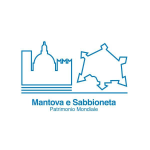MANTOVA. The transformation of a capital city
Mantua’s history stretches all the way back to when first the Etruscans and later the Romans settled on a wide bend of the River Mincio.
The original urban centre was gradually expanded over time thanks to significant land reclamation efforts.
Alberto Pitentino’s medieval feats of hydraulic engineering created four artificial lakes: Lago Superiore, Lago di Mezzo, Lago Inferiore and Lago Paiolo (now reclaimed).
In 1190, the fortified city thus became an island in the middle of the Po Valley.
But what is most admired today is Renaissance Mantua, the result of the architectural and urban renewal drive promoted by the Gonzagas.
Its layout is inspired both by an ideological vision, based on the function of the city in relation to its inhabitants, and by a political vision, reflecting the family’s power and cultural status.
The rulers of Mantua summoned some of the best-known artists of the time to their court, including Leon Battista Alberti, Andrea Mantegna and Giulio Romano.
They were commissioned to give shape to the magnificence that still characterises city today.
